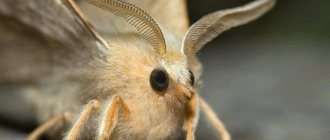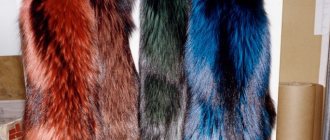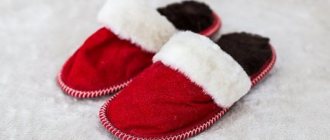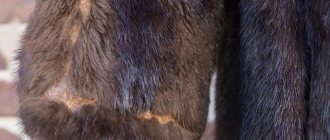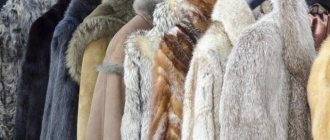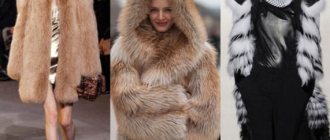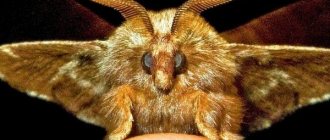The most terrible enemy of a natural fur coat is clothes and fur moths. In fact, these pests don’t care what they spoil, be it expensive fur or ordinary wool - they will all suffer to the same extent. But it is the damage to luxury winter clothing that causes the strongest wave of indignation, so every housewife should know what moth repellents exist for fur coats and how to use them to drive away the pest forever.
Description of the fur moth
There are many types of moths: clothes moth, food moth, clothes moth, grain moth. But today we will talk about the type that most upsets the female half of humanity. This is a fur moth or as it is also called a house moth. This insect feeds mainly on furs. The caterpillars are white, worm-like , naked, with eight short legs and a brown head; the body is translucent so that the insides can be seen.
The adult is sand-colored, the wings are transparent with dots in the middle, the span is about 14 - 17 mm. They live in portable cases . The adult does not have a mouthpart, so it does not feed. But it hatches larvae , which in turn spoil things. Also, female moths do not use their wings, that is, they do not fly. But the flying insects that irritate us are males. House moths are keratophages, that is, they feed on keratin , a substance that is part of the villus at the molecular level . It contains the very protein necessary for the life of an insect.
Symptoms of infection
Symptoms of moth infestation of a fur product are visible to the naked eye. The surface of the fur loses its attractiveness due to the formed lumps. Gradually, the paths and furrows eaten away by the larvae become clearly visible. The presence of pests is also indicated by the fur pile cut by them, as well as clearly visible “bald patches” on the surface of the fur product.
A moth in a fur coat does its dirty work catastrophically quickly, and any delay risks the fact that the fur coat will be irrevocably damaged.
The main enemies of fur
All fur pests can be divided into two categories: those that eat fur (fur, wool and furniture moths, carpet beetle larvae), and those that feed on the skin of the skin (meatfly, bread beetle). The damage caused to fur products by these insects is irreparable! “Bald patches” on furs, holes in the skin and “chewed” pile (fur moth) are very noticeable both on transverse mink coats or fox vests, and on muffs, hats made of sable, astrakhan fur.
Therefore, the main rule of a caring housewife is to prevent insects from appearing in the fur, because, despite the existence of effective measures to combat them, these procedures are quite labor-intensive and are not always safe for the product.
Why does it appear?
The reason moths appear in the house is that they feel truly comfortable here. The insect is completely satisfied with the air temperature, humidity, and most importantly, with a sufficient amount of a wide variety of food necessary for the fully formed caterpillar to make a cocoon for itself, turn into a butterfly and lay eggs.
Moths appear on fur coats and other fur products due to non-compliance with care rules. During wear, particles of sweat and dirt remain on the product - exactly what the moth larva needs for successful development.
Diet
What does a moth eat? It is worth distinguishing two food groups. The first includes direct food at home. The second includes natural products. The clothes parasite lays eggs in the nests of birds and rodents.
The larvae feed on fur or feathers shed by birds and animals. Under such conditions, their life cycle can significantly increase, since due to the lack of favorable conditions, the parasites have to overwinter in the form of pupae.
Insects are more comfortable in the house, since in addition to favorable temperature conditions, there is always cotton or woolen fabric, cereals, nuts, and tea in the home.
How to detect moths on a fur coat?
It is almost impossible to detect fur moth offspring in fur products at an early stage. Moth eggs are almost invisible to the eye due to their microscopic size and translucency. With the help of a special adhesive liquid, they attach to the hairs, successfully developing into larvae, which begin to actively eat someone's mink coat.
A visual inspection is effective only when obvious damage to the product is already noticeable: lumps, folds, tunnels among the fur pile, bald spots, hairs at the bottom of the cabinet, as if neatly and evenly cut.
Stages of pest development
Insect development occurs in several stages:
eggs in a dark, secluded place, for example, in a closet .
From them appear moth caterpillars , which by the time their presence is noticeable, will make a bald spot in the fur coat.
The caterpillar, when it has eaten enough and finds a secluded place, will turn into a pupa, and butterfly .
Moths in a city apartment can reproduce all year round. The normal life cycle of the pest lasts no more than 90 days.
The first signs of the presence of moths
One moth larva can “gnaw through” an entire centimeter of fabric in just a day! Therefore, in order to protect your fur coat, it is worth carefully inspecting it from time to time.
At the first sign of moths, emergency assistance is necessary. Here are some of the main obvious signs of moths on a fur coat:
• The fur is crumpled, looks dull and untidy; • There are several hairs of wool on the floor of the wardrobe; • Crumpled fur on the smooth surfaces of a fur coat; • Slightly stale smell from the product; • When ironed by hand, the villi fall out; • Small bald patches and spots are visible in the curves.
If you detect at least one such symptom, urgently free the fur from these “inhabitants”, since in the near future you risk being left without warm protection for the winter.
Let's recognize the enemy by sight
Can food moths eat fur coats? No, for this type of insect the favorite type of food is dry cereals and dried dried fruits.
food moth
The food butterfly also differs from the clothes butterfly in appearance: it is larger in size and has a “disheveled” appearance due to the special structure of the wings.
Clothes moth
Having figured out what kind of moth is eating a fur coat, it is important to determine whether it is the culprit for the fact that bald spots and even holes have appeared on your favorite thing. The first signs of its presence include:
- loss of a presentable appearance by a fur item;
- the presence of short, as if cut, hairs in a storage case or in a closet;
- the appearance of unnatural folds in damaged areas;
- hair loss after touching the surface of the fur;
A fur coat or other product gives off a slightly unpleasant and persistent odor.
Natural fur coat
How to prevent moths from appearing
How to keep a fur coat from moths? You can protect your clothes with effective preventive measures. First of all, this is proper storage of things. The use of fumigators, as well as special aerosols, shows good effectiveness. Spray them from time to time so that the insecticidal preparation gets on both the fur products themselves and the inner walls of the closet. Knowing how to protect clothes from moths, you can once and for all put an end to concerns about your favorite items of clothing.
Proper storage
The first thing you should pay attention to is how you can protect your home textiles from the mink pest. If a voracious insect starts in a wardrobe, it most often ends up on a fur coat made from completely different things. However, she will start eating it, and first of all, because fur is her favorite delicacy.
You can protect mink clothing if you allocate a separate closet for fur products. Separate these items from other items of clothing and pest problems should no longer arise. In this case, place clothes in the closet only in a clean, dry state. Additional protective measures will not hurt: place bags of citrus peels, geraniums or wormwood in the corners of your wardrobe. Their scent will repel vermin and keep them away from your favorite item.
What to process
What to do if there are moths in your fur coat? Sometimes, no matter what measures you take, fur products can still be attacked by these voracious insects. In this case, you cannot do without professional insecticides. If a fur coat has been eaten by moths, it is not too late to protect other items of clothing, so get rid of parasites quickly and radically.
Among the most popular compositions used against pests, it is worth highlighting aerosols: Raptor, Mosquitall. They do not have a strong odor, and you won’t have to worry about keeping things safe from pests.
Mechanical protection
If spray treatment may seem to some housewives not too gentle on fur items, you can resort to much more ancient methods - mechanical cleaning. In summer, it is recommended to shake out and ventilate the mink item. This is perhaps the most cost-effective way to preserve textiles from the harmful effects of insects. However, there are several disadvantages:
- physically, shaking up fur products is not so easy;
- You still won’t be able to rid your clothes of moth larvae this way.
Knowing how to store a product and how to protect it from insects is simply necessary for every housewife.
Folk remedies
You can remove moths from a fur coat using insecticides, but not by using folk methods alone. As a preventive measure, lavender, geranium, and citrus fruits should be placed in the wardrobe. As a rule, small fabric bags are taken for this (you can sew them yourself), into which sprigs of lavender, geranium or orange peels are placed. It is recommended to put these bags in covers for your moth coat. Remember: you are unlikely to be able to save something that has been eaten by a moth using folk remedies alone. But they are capable of repelling insects.
Insecticidal method
To prevent moths, not only scented covers are used, but also various tablets, plates, hanging fillers, and stickers. These items are soaked in essential oils, such as citrus, mint, lavender, pine and other repellent aromas. This is not harmful for us, but for insects it is a disastrous remedy. All kinds of aerosols will also help protect your fur item from parasites.
Fighting methods
One of the fastest ways to get rid of moths is disinfestation. There are now a lot of different aerosols in stores that quickly, without harm to the product and safely for humans, fight pests. These include Antimol, Raptor, Extramit, Clean House, Armol, etc.:
- Extramite: guarantees the death of insects a few hours after treatment. The effect lasts about six months.
- Raptor: the aerosol is suitable not only for combating existing moths, but also for prevention when storing fur coats. A single spray is sufficient for the desired effect. Does not spoil fur, including expensive ones. After killing the moth, it is advisable to spray the inside of the cabinets to prevent the parasite from reappearing.
- Clean House: to get rid of insects, you need to spray the entire apartment (especially cabinets, bedside tables, chests of drawers, where moths can appear). The products themselves do not need to be processed. You need to purchase the product at the rate of 1 cylinder per one-room apartment.
- Armol: a product with the aroma of lavender, which moths are so afraid of. Does not leave stains or other marks on the product. Suitable for getting rid of not only fur moths, but also clothing, wool and even food moths.
- Mosquitall: not suitable for all types of clothing, has a smell. Use in the same way as other aerosols.
To kill moths, you need to thoroughly spray the product on all sides, including in the folds, and also treat the cover (or a large plastic bag) from the inside, then place the fur coat in it and fasten it. Keep it this way for several days, during which it is advisable to additionally spray it with an aerosol inside the cover.
Aerosol Extramite
Aerosol Clean House
Aerosol Armol
Aerosol Raptor
If there are no special ones on hand at the right time, you can use other aerosols against crawling and flying parasites. But at the same time, you need to make sure that these preparations do not spoil the fur, leaving stains on it and a smell that does not disappear for a long time. Otherwise, the product can be taken to the dry cleaner, where it will be treated with heat, which will kill the moth, since it cannot tolerate high temperatures.
Fur coat cover
Among other means of control, you can use fumigators, but this will take time (about 2 weeks). In this case, the device must work in the cabinet itself, so you cannot do without an extension cord.
Sometimes special anti-moth sections are used against moths, but this product is good for repelling insects. It cannot destroy parasites, as it works on the basis of essential oils.
Among traditional methods, lavender essential oil or dried orange peels placed in cabinets are acceptable. But these means will not have a destructive effect either. They also mainly work only as a deterrent and are good as a preventive measure.
Methods of protection
Preventing moths from appearing in your wardrobe requires some effort, but prevention is guaranteed to save valuable fur from the jaws of the pest. We suggest considering several methods that will tell you how to protect your fur coat from moths.
Separate wardrobe
As a rule, an insect that eats wool products ends up on a fur coat by accident. But since these parasites are quite unpretentious in food, they begin to spoil expensive fur with great joy.
Aerosols
Use aerosol insecticides. Today there is a fairly wide selection of such products and they are easy to find on the open market. The most popular and effective are:
- Raptor;
- Mosquitall;
- Antimol;
- Armol.
They are absolutely harmless to the fur coat, do not leave any traces and do not saturate the fur with their aroma (as a last resort, you can purchase an unscented product). These brands have specially developed fur protection products that are easy to use and highly effective. The aerosol must be sprayed from time to time on the inside surface of the closet and on the fur coat itself. The frequency of this procedure can be seen in the instructions that come with each drug.
Fumigators
Fumigators are also an excellent preventive measure. They are very easy to use and do not require any physical effort on your part. To place the fumigator in the cabinet, use an extension cord.
This product repels moths very effectively, and even if for some reason a butterfly gets into the wardrobe, the device will not give it the opportunity to reproduce and the insect will soon die.
Case
Use special covers for fur coats against moths. They are made in the form of thin cases and have a reasonable price. Adult butterflies and larvae are repelled by the aroma that permeates the inner surface of the case. In addition, they close very tightly, which prevents moths from getting inside.
The most popular and effective case is the one from the Raptor brand. When producing it, the manufacturer took into account all the peculiarities of the insect’s existence, and this cover perfectly repels both adults and caterpillars.
Advice! Fur products are usually sold in covers. Save them, this will be enough if you do not have the opportunity to purchase a special case.
Post-purchase inspection
It is very important to carefully inspect it before purchasing an expensive product, since even in elite salons the fur can be contaminated. Carefully examine the fur coat for thin, long tracks of trimmed fibers. When you arrive home, you must hang it on the balcony.
Advice! You can air the fur only in absolutely dry weather, and this can be either a warm sunny day or winter frost.
Even if moth larvae already live in a new fur product, direct sunlight or low temperatures are guaranteed to destroy them.
A few more tips:
Now you know which plant repels moths with its smell. Finally, remember a few important rules:
- Anti-moth plants should be used immediately, avoiding severe infestation of the room with butterflies;
- Change the products periodically - once the insect gets used to one scent, it will stop reacting to it. Remember, dry herbs retain their fragrant properties for 2-3 months;
- For an enhanced attack, use a whole collection of aromatic plants.
Where do moths come from in an apartment and how to get rid of them? This is interesting to know!
Actions to take if a fur product is contaminated
A product can become infected during storage in the warm season or if there are larvae in the closet or room where it is stored.
Signs of infection
The signs are easy to spot, as they are immediately obvious. This:
- A fur coat affected by moths loses its attractive appearance and lumps form on the surface.
- The folds and wrinkles that form are paths cut by the larvae.
- Trimmed fur pile.
- Formed bald patches on the surface.
- Presence of butterflies in the room where the product is located.
If you notice one or more of these signs, it is important to take action.
How to save a product
There are several ways to save a fur coat damaged by moths. If the situation is not critical:
- You can tint your bald spots to match the color of your fur.
- A small “bald spot” can be cut out, and the edges from the inside can be sewn together again.
- A spot in the chest or collar area can be decorated with a brooch.
In some situations, you can shorten the product or cut off the sleeves and make a fur vest.
How to quickly kill insects
Fur owners need to know what to do if moths have already appeared. It is necessary to destroy the larvae as quickly as possible; for this purpose, anti-moth products for fur coats are suitable, which can destroy insects in a matter of hours. After treating your fur coat with insecticidal agents, you need to put it in a plastic bag for several days or use dry cleaning services, where the product will be treated at high temperatures.
Insecticides and aerosols are effective. In special stores you can choose for every taste and budget. Raptor extramit, Armol, Clean House have proven themselves well.
It is sometimes difficult to save a mink coat, it all depends on the degree of damage to the fur. If you choose the right moth repellent for your fur coat, you can easily remove even the largest horde of insects.
Interesting read
Improper storage is also often the cause of foul smelling fur. If the product is hung in a closet damp, and even in a plastic bag, the fur may “suffocate” and a moldy smell will appear.
If the new clothes were made from raw materials that were stored in a warehouse for a long time and became damp, then this may also be the cause of the bad smell. “Stale fur coats,” as one owner of a large fur retail chain put it—these are models made from old, low-quality raw materials, or those that hung unclaimed in the store for a long time—this is one of the reasons for the smell.
White fur coat
Also, the unpleasant odor from mink fur may be associated with the anti-moth treatment that is used in stores. Usually this smell disappears on its own.
Dry the fur item thoroughly. Then fold the fur coat with the fur inward and place it in a thick plastic bag. Place the bundle in the freezer (it is advisable that there is no food in this freezer compartment), and remove it after 1-2 days. Unfold the fur coat and hang it in a dry, well-ventilated place. With the help of freezing, you can rid a fur product of even the most persistent odors.
Protect woolen items from moths
Moths spoil not only mink coats, but also any items made of mouton and natural wool. After the summer season, you can find battered hats, scarves, sweaters and dresses, which also does not add optimism and joy. You can protect such clothes if you follow a few rules:
- Store things only in clean form. The smell of sweat and various stains are considered attractive to beetles. Before packing items, they must be washed or cleaned and dried thoroughly.
- Use sealed bags, preferably vacuum ones.
- Treat clothing and the inside of the package with a special spray before packaging.
- Place a tablet/wafer or bag of lavender inside the bag.
Hardened
If you haven't managed to dry your fur coat, the inner layer may harden, as in the photo. If the mink coat is wet and rough, you will need to rip the hem of the coat and try to soften the inside. To do this, you need special products designed to soften the skin. If you are confident that you can handle it on your own, then start this painstaking work. If you are not confident in yourself, then it is better to seek help from specialists.
It is necessary to prepare a special solution. In one liter of water at 20-22 degrees, dissolve salt - 1.5 tablespoons and vinegar essence - 2 tablespoons. Apply the prepared solution generously to the skin and leave for 30-40 minutes. Then we begin to gently knead the skin with our hands. This procedure should be done three times, taking a break of 2-3 hours. Now the fur coat needs to be allowed to dry thoroughly.
After washing
After washing, you suddenly discover that your favorite mink coat has shrunk. Most likely, the skins of your product were not of high quality. This defect is difficult to correct. Here you also need the help of professionals who, with the help of additional pieces of similar fur material, can increase the size of the fur coat.
Prevention and rules for storing fur coats
Before you send your furry beauty into “summer hibernation,” you need to carefully prepare. This will prevent the appearance of pests.
To do this, it is recommended to carry out the following activities:
- Be sure to clean the product after the end of the season. Existing traces of wear are removed by dry cleaning.
- Fix any problems with the fittings. Carry out cosmetic repairs if necessary.
- Take care of a protective anti-moth cover, which will prevent parasites from getting to the treat. Don't skimp on this accessory. You can purchase covers soaked in essential oils, which moths really don’t like.
- To prevent pests from touching the fur product, create favorable storage conditions, ventilate the product from time to time, and let it breathe.
Danger to humans
Knowing about the ability of moths to damage natural fabrics and food, you should carefully approach the choice of goods when purchasing.
Not all suppliers guarantee the quality of the product; cereals on store shelves may contain parasite larvae, and if the clan penetrates into a home, it will quickly begin to reproduce in favorable temperature conditions.
If you eat affected cereal, then in addition to the larvae in the plate, you can get severe poisoning. The fact is that at the site of parasite production, traces of their vital activity, skins and feces remain.
Therefore, to avoid ending up in a hospital in serious condition after eating cheap cereal, contaminated bags should be disposed of.
The second life of a moth-damaged fur coat
A moth has chewed on your fur coat, are you in despair, don’t know what to do with it? There is a way out of any situation, sometimes very simple, and sometimes expensive.
Before you get upset, evaluate the scale of your losses:
- If you notice minor stains on the collar, it may be enough to simply cover the flaw with a scarf or shawl.
- A chest island will hide a brooch of a suitable size, with a distracting effect.
- If the larva has damaged inconspicuous places, you can simply shade them with paint, a marker, shoe polish, just choose the tone.
- If you need to get rid of the affected areas on your fur coat, perform a small “operation”. To do this, cut out the infected areas and try to sew the incision. But first, make sure you can do it without being noticed.
- For severely damaged clothing, you may have to get creative. For example, make leather inserts, shorten the product, change the length of the sleeves, and so on. It is quite possible to recut the fur coat.
- What remains, on the one hand, is the easiest, and on the other hand, the most expensive option, when nothing can be done - buy a new fur item from a mouton or mink.
We showed a photo of what a fur coat looks like when eaten by moths, and told us how to prevent such a nuisance. Don’t let your favorite, perhaps your only, fur coat fall into disrepair. Consider the recommendations that will help you avoid the appearance and proliferation of moths in your wardrobe.
